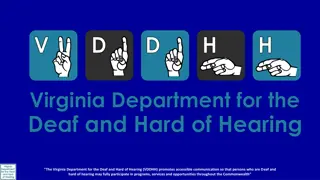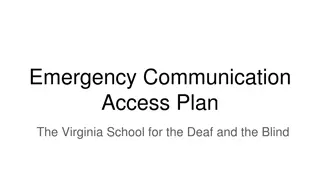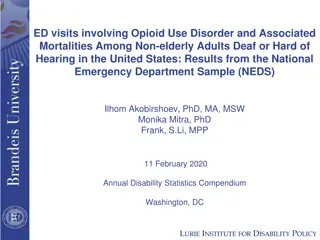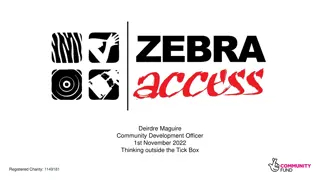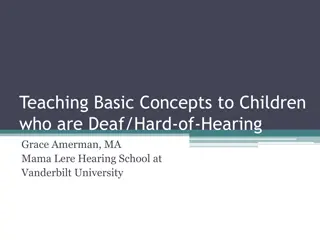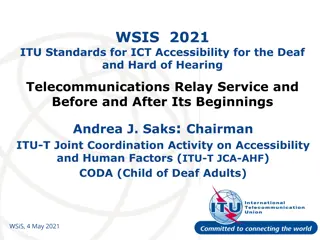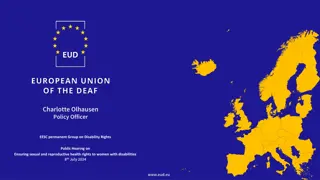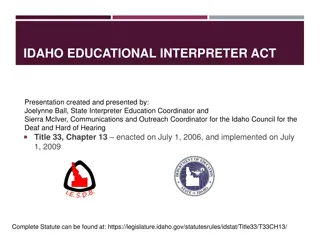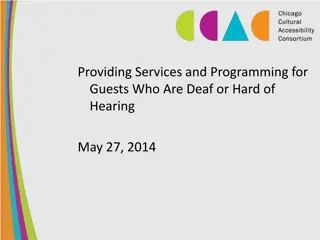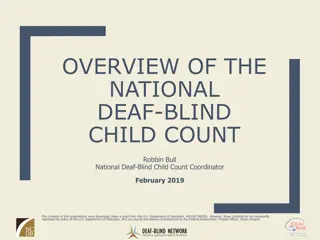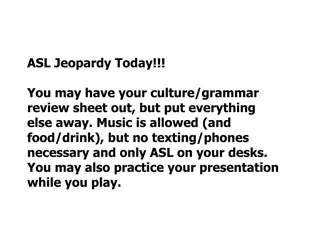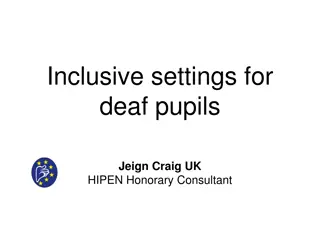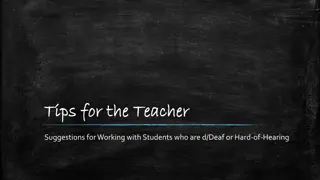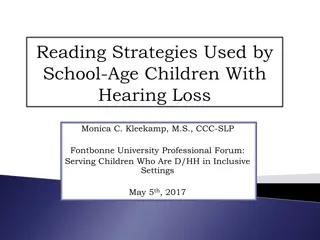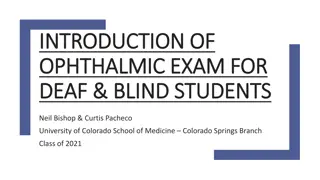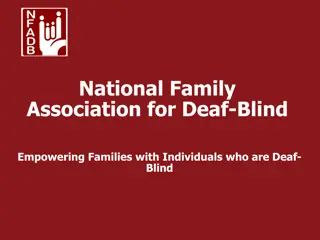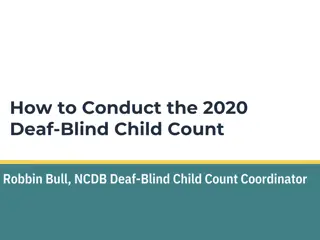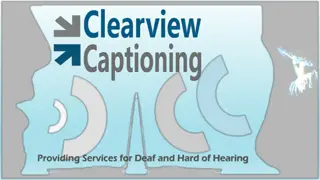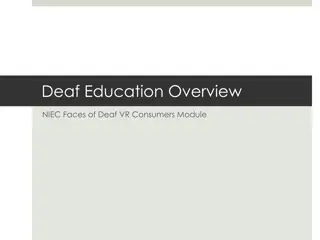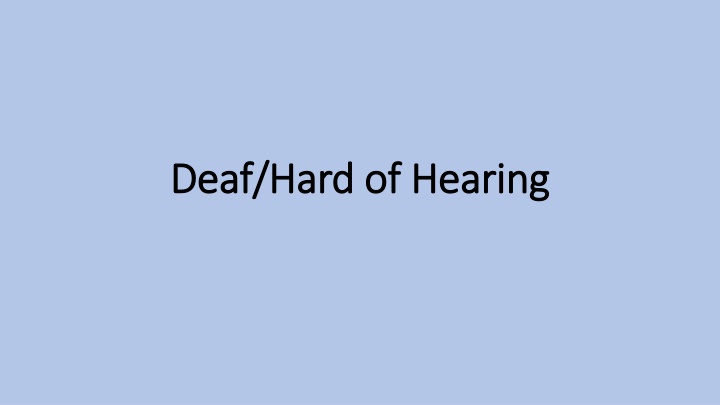
Understanding Deafness and Hearing Impairment in Education
Learn about Deafness and Hearing Impairment as defined under IDEA, eligibility criteria for educational support, professional advocacy organizations, identification and assessment methods, and the prevalence of hearing loss among students in the US education system.
Download Presentation

Please find below an Image/Link to download the presentation.
The content on the website is provided AS IS for your information and personal use only. It may not be sold, licensed, or shared on other websites without obtaining consent from the author. If you encounter any issues during the download, it is possible that the publisher has removed the file from their server.
You are allowed to download the files provided on this website for personal or commercial use, subject to the condition that they are used lawfully. All files are the property of their respective owners.
The content on the website is provided AS IS for your information and personal use only. It may not be sold, licensed, or shared on other websites without obtaining consent from the author.
E N D
Presentation Transcript
Deaf/Hard Deaf/Hard of Hearing of Hearing
Definition Definition IDEA Definition 300.8 (c) (3) Deafness means a hearing impairment that is so severe that the child is impaired in processing linguistic information through hearing, with or without amplification, that adversely affects a child s educational performance. Deaf: These students use vision as the primary sensory mode for learning and communication. Hard of hearing: These children use their hearing to understand speech with the help of a hearing aid. Many persons who are deaf do not view hearing loss as a disability.
Eligibility Criteria Eligibility Criteria Deafness and Hearing Impairment are clinical terms as well as separate educational disability classifications, under the IDEA. The eligibility criteria for both Deafness and Hearing Impairment requires documentation of an adverse educational impact and the need for specially designed instruction, which is not based solely on a clinical or medical diagnosis. The terms deaf or hard of hearing and hearing loss are now utilized. The term hard of hearing may also be used in place of hearing impairment for the eligibility determination.
Professional Advocacy Organizations Professional Advocacy Organizations VDOE Deaf and Hard of Hearing VDOE lists a wide range of organizations for supporting children, youth, and adults who are deaf or hard of hearing based on communication preferences.
Identification and Assessment Identification and Assessment The Joint Committee on Infant Hearing recommends that all infants be screened by 1 month of age Auditory Brain Stem Response Otoacoustic Emission Screening Pure-Tone Audiometry Assessed using an audiometer Speech Reception Test Alternative Audiometric Techniques Play Audiometry Operant Conditioning Audiometry Behavior Observation Audiometry
Prevalence Prevalence In 2020 21, the number of students ages 3 21 who received special education services under the Individuals with Disabilities Education Act (IDEA) was 7.2 million, or 15 percent of all public school students. >1% of all school-age children in special education, ages 3 through 21 years, received special education under the category of Deaf. The large majority of persons with hearing loss are 65 years of age or older. Males are more likely than females to experience hearing loss.
Causes Causes Genes are responsible for hearing loss among 50% to 60% of children with hearing loss. About 20% of babies with genetic hearing loss have a syndrome (for example, Down syndrome or Usher syndrome). Infections during pregnancy in the mother, other environmental causes, and complications after birth are responsible for hearing loss among almost 30% of babies with hearing loss. Congenital cytomegalovirus (CMV) infection during pregnancy is a preventable risk factor for hearing loss among children. 14% of those exposed to CMV during pregnancy develop sensorineural hearing loss (SNHL) of some type. About 3% to 5% of those exposed to CMV during pregnancy develop bilateral moderate-to-profound SNHL. A 2005 HealthStyles survey by CDC found that only 14% of female respondents had heard of CMV.
Characteristics Characteristics Students who receive special education because of hearing loss are a heterogeneous group. Levels of functioning influenced by: Type and degree of hearing loss Age of onset Attitudes of the child s family Opportunities to acquire a first language Presence or absence of other disabilities Generalizations about how deaf people are supposed to act and feel must be viewed with extreme caution.
English Literacy English Literacy Students with hearing loss: Have smaller vocabularies than their peers with normal hearing and the gap widens with age Learn concrete words more easily than abstract words Have difficulty with function words and omit endings of words Have difficulty differentiating questions from statements Have difficulty understanding and writing sentences with passive voice and relative clauses
Academic Achievement Academic Achievement Atypical speech is common in many children who are deaf or hard of hearing. Students with hearing loss have difficulty with all areas of academic achievement, especially reading and math. The gap in achievement between children with normal hearing and those with hearing loss usually widens as they get older. Problems are attributable to inadequate development of a first language and the mismatch between the demands of spoken and written English and the students ability to understand and communicate in English.
Social Functioning Social Functioning Behavioral difficulties in school and social situations are more likely in children with hearing loss than in children with normal hearing. Reports of feelings of depression, withdrawal, and isolation frequently reported by children and adults who are deaf with adventitious hearing loss. The extent to which a child with hearing loss successfully interacts depends on others attitudes and the child s ability to communicate in some mutually acceptable way.
Instructional Strategies Instructional Strategies Oral/Aural Approaches Auditory Learning Speech Reading Cued Speech Total Communication Manually Coded English Fingerspelling American Sign Language (ASL) ASL is the language of the Deaf culture in the U.S. and Canada Bilingual-Bicultural Approach
Accommodations/Modifications Accommodations/Modifications Hearing Aids Digital programmable hearing aids The earlier in life a child is fitted the more likely he will learn to use hearing Group Assistive Listening Devices A radio link established between the teacher and the child with a hearing loss Sign Language Interpreters signing the speech of a teacher or other speaker for a person who is deaf Speech-to-Text Translation computer devices that translate speech to text Television, Video, and Movie Captioning printed text that appears at the bottom of the screen Text Telephones allows the user to send a typed message over telephone lines to anyone who has a teletype. Computer Technology and Alerting Devices
Placements Placements The majority of children who are deaf or hard of hearing attend local public schools 63% receive most of their education in regular education classrooms with hearing students 15% attend resource rooms for part of the school day 11% are served in separate classrooms 2% attend residential schools for the deaf About 50% of all students with hearing loss go on to college.

